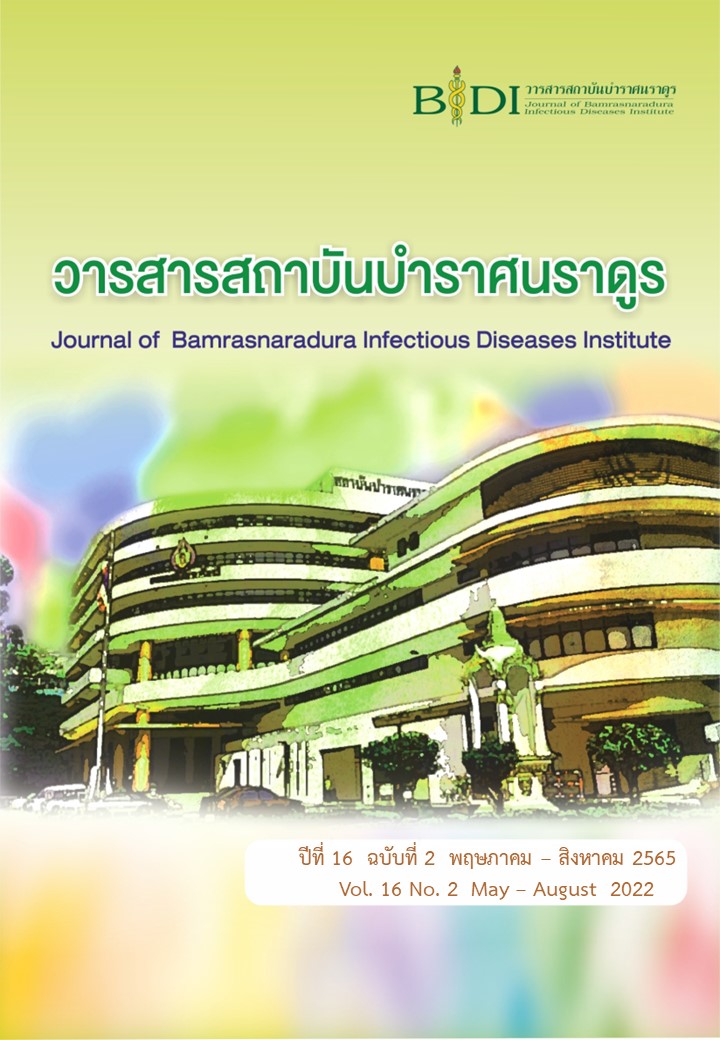ผลของการใช้แนวทางปฏิบัติดูแลผู้ป่วยติดเชื้อดื้อยา สถาบันบำราศนราดูร
Main Article Content
บทคัดย่อ
การวิจัยครั้งนี้เป็นการวิจัยเชิงปฏิบัติการ (Action Research) เพื่อพัฒนาแนวปฏิบัติการดูแลผู้ป่วย เพื่อลดอัตราการติดเชื้อดื้อยาลดลง โดยยึดนโยบายความปลอดภัย ของสถาบันบำราศนราดูร 2P-Safety Goals ผสมผสานและประยุกต์ใช้กรอบแนวคิดกระบวนการบริหารงานคุณภาพ แบบวงจรคุณภาพเดมมิ่ง (PDCA) ประกอบด้วย 4 ขั้นตอน คือ1) การวางแผน (Plan)2) การปฏิบัติ (Do)3) การตรวจสอบ/การสังเกต (Check) 4) การปรับปรุง (Action) กระบวนการพัฒนาคุณภาพเปรียบเทียบผลการดำเนินงาน ในหอผู้ป่วยที่มีอัตราการเกิดการติดเชื้อดื้อยาบ่อยที่สุด 4 หอผู้ป่วย จากทั้งหมด 13 หอผู้ป่วย ดำเนินการวิจัยในช่วงเดือนตุลาคม 2561 ถึงกันยายน 2562
ผลการศึกษา สถาบันบำราศนราดูร มีแนวทางปฏิบัติที่ใช้ดูแลผู้ป่วยติดเชื้อดื้อยา “CPM caring MDR” โดย C= Communication สื่อสารในทีม ผู้ป่วยและญาติผู้ดูแล, P= Practice ปฏิบัติตาม Check list ดูแลผู้ป่วยติดเชื้อดื้อยา, M= Monitor ติดตามควบคุมกำกับโดยทีมดูแลผู้ป่วย (ICWN, ICN) เมื่อเปรียบเทียบคะแนนก่อนและหลังการใช้แนวทางปฏิบัติการดูแลผู้ป่วยติดเชื้อดื้อยา พบว่ามีความแตกต่างอย่างมีนัยสำคัญที่ p < 0.001 ซึ่งข้อมูลด้าน Hand Hygiene และ Staff education ปฏิบัติได้ดีขึ้นอย่างมีนัยสำคัญทางสถิติที่ p < 0.001 อัตราการติดเชื้อในโรงพยาบาล และอัตราการติดเชื้อดื้อยา มีแนวโน้มลดลง
ข้อเสนอแนะ : เมื่อโรงพยาบาลมีแนวทางการปฏิบัติงาน รวมทั้งมาตรการควบคุม และป้องกันการ ติดเชื้อในโรงพยาบาลที่มีประสิทธิภาพ บุคลากรปฏิบัติตามอย่างเคร่งครัด โดยผู้ป่วยติดเชื้อดื้อยาทุกรายปฏิบัติตาม Contact Precaution & Isolation การใช้ Using effective disinfectants เครื่องมืออุปกรณ์ทางการแพทย์แยกเฉพาะ อาหารและน้ำดื่มจัดใส่ภาชนะบรรจุชนิดใช้ครั้งเดียวแล้วทิ้ง เพิ่มความถี่ในการทำความสะอาดอุปกรณ์เครื่องใช้และสิ่งแวดล้อม รวมทั้งมีระบบการมอบหมายหน้าที่ในการดูแลผู้ป่วยดื้อยาเฉพาะราย จะสามารถลดอัตราการติดเชื้อดื้อยา ลดอัตราการติดเชื้อในโรงพยาบาล ผู้รับบริการก็มีความปลอดภัยมากขึ้น
Article Details
References
Indrawattana N. and Vanaporn M. Nosocomial infection. Journal of Medicine and Health Sciences 2015; 22 (1): 81-92. (in Thai)
Ministry of Public Health, Ministry of Agriculture and Cooperatives, National HealthCommission Office, National Health Security Office, Thai Health Promotion Foundation, Center for Monitoring and Developing Drug Systems, International Health Policy Program, Heath Systems Research Institute, Food and Agriculture Organization of the United Nations and World Health Organization. Thailand Antimicrobial Resistance Management Strategy 2017-2021. [Internet].2017 [cited 2019 May 15].Available from: http://www.fda.moph.go.th/sites /drug /Shared%20Documents/AMR/01.pdf (in Thai)
Chanvatik S, Sommanastaweechai A, Patcharanarumol W, Witthayapipopsakul W, Mattrasongkram P, Thunyahan A and Tangcharoensathien V. The Integration of Monitoring and Evaluation Mechanism for Public Awareness of Antimi- crobial Resistance into the Health and Welfare Survey. Journal of Health Systems Research 2017; 11(4): 551-563. (in Thai)
Thamlikitkul V, Rattanaumpawan P, Boonyasiri A, Sirijatuphat R. and Jaroenpoj S. Operational Actions of the Thailand Antimicrobial Resistance (AMR) Containment and Prevention Program in Response to the World Health Organization (WHO) Global Action Plan on AMR. Journal of Health Systems Research 2017; 11(4): 453-470. (in Thai)
Suttajit S, Sumpradit N, Hunnangkul S, Prakongsai P. and Thamlikitkul V. Hospital Infection Control and Antimicrobial Stewardship Programs among Public and Private Hospitals in Thailand. Journal of Health Systems Research 2013; 7(2): 281-295. (in Thai)
World Health Organization. Antimicrobial resistance in the South-East Asia. [Internet]. 2018 [cited 2019 April 8]. Available from: https://www.who.int/southeastasia/health-topics/antimicrobial-resistancepdf.
Unahalekhaka A, Lueang-a-papong S. and Chitreecheur J. Prevention of Multidrug Resistant Organism Infections in Intensive Care Unit. Health Systems Research Institute. [Internet]. 2014 [cited 2019 June 11]. Available from: http://164.115.27.97/ digital/files/original/ f5903daddf05e49e5a697c701a475bca. pdf. (in Thai)
Uppanisakorn S., Tinnikom K. and Boonyarat J.The outcome of control the bacterial multidrug-resistant in medical ICU, tertiary hospital. Region11 Medical Journal 2017; 31(4): 649-656. (in Thai)
Kredo T., Bernhardsson S., Machingaidze S., Young T., Louw Q., Ochodo E.and Grimmer K. Guide to clinical practice guidelines: the current state of play. International Journal for Quality in Health Care 2016; 28 (1): 122-128. doi: 10.1093/intqhc/mzv115.
Wisetsiri P, Unahalekhaka A. and Kasatpibal N. Development of a Model for Promoting Practices to Prevent Drug-resistant Organisms Infections among Nursing Personnel, Medical Department of a Tertiary Care Hospital. Nursing Journal 2014; 42(3):119-134. (in Thai)
Puttaruksa L, Subgranon R. and Othaganont P. Factors Leading to Success in the Implementation of Evidence Based Nursing Practice of Professional Nurses. The Journal of Faculty of Nursing Burapha University 2016; 24(3): 94-103. (in Thai)
Rosenfeld R, Shiffman R and Robertson P. Clinical Practice Guideline Development Manual, Third Edition: A Quality-Driven Approach for Translating Evidence into Action. Otolayngo-Head and Neck Surgery 2012; 148(IS): S1-S55. doi.org/10.1177/0194599812467004.
Parikumsil N, Pengluo S and Saysom S. Effects of the Prevention and Control Program for Special types of Multi-Drugs-Resistant Bacterial on Knowledge and Practices among Health Care workers in Intensive Care Unit, Photharam Hospital . Hua Hin Sook Jai Klai Kangwon Journal 2018; 3 (2): 49-57. (in Thai)

